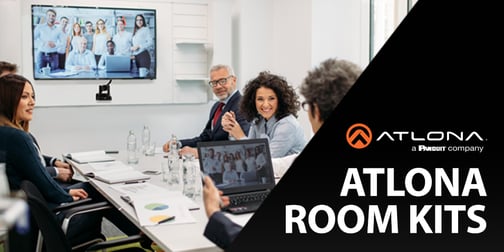In this blog post from Atlona and Panduit, we explore how remote and hybrid work can be made more efficient and connected. As the working world continues to evolve, taking these technologies into consideration can help you enable collaboration, wherever your employees are located.

It's safe to say there are and will continue to be many unknowns as we continue to navigate through these times. We've changed the way we do business, how we work as individuals and teams, and how we manage our families and home lives.
Companies are developing plans that position them as the employers of choice as they allow employees to come back to the office. Developing such a plan is no easy task, as no two employees have had the same experiences over the last two years. Some are eager to get back to in-office work, and some are hesitant to say goodbye to full remote work. Companies are tasked with finding a middle ground and supporting employees as they, yet again, learn a new norm.
Being an Employer of Choice
According to a recent survey conducted by IDG Communications and Marketpulse Research on behalf of Panduit, the number of desk employees working in a hybrid capacity is expected to grow to 31% of employees, up from 18% in January 2020. On average, 27% expect to be fully remote, up slightly from the pre-2020 average of 20%. With companies adapting new technologies to support hybrid work, it's easier than ever to offer employees options that give them flexibility and keep them engaged in the company culture. We've seen remote communication and online collaboration work in a setting where we are all remote. Now, it's up to IT and Facilities teams to create that same experience in-office for those who choose to come in and those who prefer to stay home and work remotely.
Investment in Technology
The primary focus for companies will be on health and safety, collaboration, and space optimization in their buildings, as well as the technologies needed to support these key elements. To start, we need conference room equipment that allows for little-to-no contact. Audio-visual equipment that enables in-person employees to use their own devices to connect wirelessly is preferred. Additionally, in-room cameras should give remote participants the ability to see the entire room, making them a true part of the conversation. Touch-free room controls can also allow users to adjust the room to the uniqueness of the meeting without having to manually adjust mics, displays, cameras, etc. These types of investments in technology allow for future changes based on the future of what we'll learn we need.
How Is This Possible?
Atlona recently launched Room Kits, which allow for quick, repeatable conference room designs that reduce the amount of time needed for upgrades, allowing you to make future changes easily. These designs are pre-configured, which means less time for installation and faster, more reliable designs. Each room kit is designed for a specific space (huddle room, small conference room, medium conference room, or training room) and allows for content to be presented via a display or video conferencing. Each kit includes everything you need to support a hybrid meeting: video source, display, networking, microphone, audio and camera. All of the components are preconfigured and tested, so when they arrive onsite, the work is already 80% and the kits are ready to hang and use in hours, rather than days. If you're looking for AV solutions that allow you to quickly update multiple rooms, make future adjustments without needing a technology overhaul, and are really ready to create the hybrid work experience your employees need and want, this is the solution for you.
Contact your local Accu-Tech representative to get started, and learn more about Atlona and Panduit here.


.png?width=58&height=58&name=X_logo_2023_(white).png)
